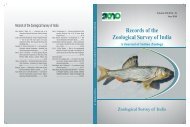Vol. 111 - Part I - Zoological Survey of India
Vol. 111 - Part I - Zoological Survey of India
Vol. 111 - Part I - Zoological Survey of India
You also want an ePaper? Increase the reach of your titles
YUMPU automatically turns print PDFs into web optimized ePapers that Google loves.
MURMU et al. : A population survey <strong>of</strong> Rhesus monkeys and Hanuman langurs <strong>of</strong> Puri......Orissa, <strong>India</strong> 21<br />
were juveniles and 59 were infants. The mean density<br />
<strong>of</strong> langurs harboring different habitats is shown in Fig.<br />
4. The two status survey <strong>of</strong> non-human primates <strong>of</strong><br />
Puri and Khurda districts revealed a huge change <strong>of</strong><br />
population over a period <strong>of</strong> about 26 years.<br />
To find out the changes that occurred, were selected<br />
20 common langur groups were selected from the both<br />
surveys inhabiting all categories and distributed at<br />
different places throughout the districts. The 1978<br />
survey was conducted in the month <strong>of</strong> May. A number<br />
<strong>of</strong> surveys were conducted for the study <strong>of</strong> status <strong>of</strong><br />
primates in 2003-2004 and 20-langur groups were chosen<br />
from the survey carried out during the month <strong>of</strong> May<br />
2003 so as to make comparative study. These 20 groups<br />
contained 332 in 1978 survey and 335 langurs in 2004<br />
survey (Table-5, Fig. 3). The only major changes were<br />
noticed in the adult males and adult female’s<br />
populations. In 1978, 9.3% males and 51.2% females<br />
were recorded whereas during 2003 survey it was<br />
12.2% males and 47.7% females were observed. The ‘t’<br />
test <strong>of</strong> these two population yielded insignificant results<br />
(t = – 0.043, p value Pct < = t).<br />
360<br />
300<br />
240<br />
180<br />
120<br />
60<br />
0<br />
DISCUSSION<br />
The rhesus monkeys <strong>of</strong> Puri and Khurda districts<br />
were found inhabiting the forests and temples. Out <strong>of</strong><br />
18 rhesus groups from 5 groups were recorded from<br />
temples and 9 groups from forests. The forest dwelling<br />
monkeys represented 42.7% <strong>of</strong> the total recorded<br />
population in these two districts. The forest provides<br />
natural food and shelter to these monkeys, whereas<br />
provisional food provided by the visitors to the temple<br />
monkeys was main factor for their concentration in the<br />
temples.<br />
In 1978 survey 3 temple groups were recorded <strong>of</strong><br />
which 2 groups were from Puri town. The Jagannath<br />
temple group was the largest with 64 monkeys, whereas<br />
the survey <strong>of</strong> 2004 recorded 5 temple groups from Puri<br />
town. The number <strong>of</strong> monkeys <strong>of</strong> Jagannath temple<br />
had increased to 134 in number. The Jagannath temple<br />
monkeys as observed were not a single group. The<br />
area <strong>of</strong> the temple is nearly 1 km2 and we tried time and<br />
again to ascertain the sleeping but due to restrictions<br />
number <strong>of</strong> groups <strong>of</strong> our movement during evening<br />
hours it was not possible to trace the night individual<br />
Table-4. Distribution and social composition <strong>of</strong> Hanuman Langur at Puri and Khurda during the year 1978.<br />
Habitat Total Males Females Juveniles Infants<br />
Forest 157 18 80 31 28<br />
Town 45 5 23 5 12<br />
Temple 36 3 20 4 9<br />
Village 354 32 185 78 59<br />
Table-5. Social composition <strong>of</strong> Hanuman langurs during summer <strong>of</strong> 1978 & 2004 <strong>of</strong> Puri & Khurda districts.<br />
Year Total Males Females Juveniles Infants<br />
Total (1978) 332 31 170 62 69<br />
Total (2004) 335 41 160 71 63<br />
Total Male Female Juvenile Infant<br />
Forest<br />
Town<br />
Temple<br />
Village<br />
Fig. 4. Distribution & Social composition <strong>of</strong> Hanuman langur<br />
at Puri & Khurda districts-1978.<br />
400<br />
350<br />
300<br />
250<br />
200<br />
150<br />
100<br />
50<br />
0<br />
Total Male Female Juvenile Infant<br />
Total (1978)<br />
Total (2004)<br />
Fig. 5. Distribution & Social composition <strong>of</strong> Rhesus macaque<br />
at Puri & Khurda districts-1978.
















